 Ewing Automotive is a preferred installer of Jasper Engines. Jasper Engines come with a 3 year 100,000 mile nationwide warranty in most cases.
Why get rid of your car when all it may need is a remanufactured engine. You’re familiar with your car. You know where all the buttons are. In most cases, it’s probably paid for. Putting a new engine in your car will give you many more years of service at the fraction of the cost of a new one.
Don’t buy a junkyard engine when your car already has one. When buying a junkyard engine, you have no idea what you are really getting. When buying a quality remanufactured engine, whether it be diesel or gas, you get peace of mind knowing exactly what you’re getting plus a great warranty.
Ewing Automotive is a preferred installer of Jasper Engines. Jasper Engines come with a 3 year 100,000 mile nationwide warranty in most cases.
Why get rid of your car when all it may need is a remanufactured engine. You’re familiar with your car. You know where all the buttons are. In most cases, it’s probably paid for. Putting a new engine in your car will give you many more years of service at the fraction of the cost of a new one.
Don’t buy a junkyard engine when your car already has one. When buying a junkyard engine, you have no idea what you are really getting. When buying a quality remanufactured engine, whether it be diesel or gas, you get peace of mind knowing exactly what you’re getting plus a great warranty. 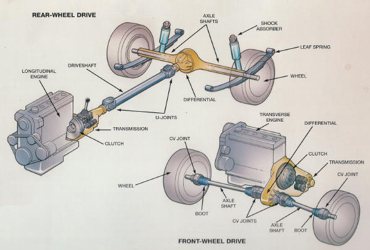 Ewing Automotive’s technicians are trained to diagnose your drivetrain problems. We can check for noises and vibrations. Our technicians have years of experience with automotive drivetrains.
Whether it is something as simple as a CV axle or U-Joint or something as complicated as an automatic transmission or differential we can help. We have the ability to rebuild your transmission or differential here at our shop.
Want a great warranty on a remanufactured transmission or differential? We offer Jasper engines, transmissions and differentials. Jasper units come with a 3 year 100,000 mile nationwide warranty in most cases.
Ewing Automotive’s technicians are trained to diagnose your drivetrain problems. We can check for noises and vibrations. Our technicians have years of experience with automotive drivetrains.
Whether it is something as simple as a CV axle or U-Joint or something as complicated as an automatic transmission or differential we can help. We have the ability to rebuild your transmission or differential here at our shop.
Want a great warranty on a remanufactured transmission or differential? We offer Jasper engines, transmissions and differentials. Jasper units come with a 3 year 100,000 mile nationwide warranty in most cases. 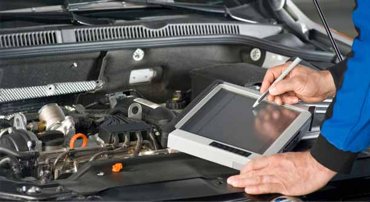 Ewing Automotive offers complete automotive and light truck diagnostics. Today’s vehicles are run by several computers or control modules. To give you an idea of what I am talking about, the engine is managed by an electronic control module, or ECM. These control modules monitor and control the fuel, emissions, temperature, the timing of the engine, braking, starting, charging, transmission shifting and speed. The electrical accessory systems that add luxuries like power windows, door locks, seats, mirrors, heating and air conditioning, are also run by a control module, called a body control module or “BCM”.
When one of these systems in your vehicle starts malfunctioning, a driver is alerted by either the illumination of a warning light on your dash. The vehicle could also start malfunctioning by not starting, a rough idle, running poorly or a loss of power, or the fuel economy level could have changed, or possibly another symptom. In order to properly diagnose what is going on with the vehicle and conclude what the proper repair would be, it takes knowledge, equipment and time for the automotive technician to run the needed tests. Unfortunately, when you tap into the vehicle’s ECM it does not tell you what is wrong. In fact, the ECM makes adjustments and changes to compensate for the symptom that it is seeing, so the vehicle will still operate as close to normal as possible. The diagnostic process starts with retrieving the code or codes from the ECM. These codes give you the circuit or circuits that are affected, and that the condition that the vehicle’s computer is seeing. From there a qualified diagnostic technician follows a diagnostic path of pinpoint testing to find the source of the problem and what is causing the condition.
As a comparison a medical doctor has to run tests on patients that are having symptoms to find what is causing a health symptom or condition. The initial exam and tests have a charge associated with them, whether they are blood tests, biopsies, x-rays or scans. Much the same an automotive repair shop too, has a charge associated for that testing time and the expertise of the technician that it takes to perform these tests and form a conclusion based on the information gathered from these tests. To be honest this diagnostic process can be the most complicated part of vehicle repair. The technician who is delegated this task is a specialist in vehicle computer diagnostics. These technicians, constantly continue to further their education, training and upgrading of their tools and equipment, since the systems on vehicles are constantly evolving and changing.
The diagnostic equipment used in most repair shops is not a simple hand held code reader like you find at most auto parts stores. These hand held scanners will give a general idea of where to look for a problem but do not show how each circuit is functioning. The diagnostic tools we use cost thousands of dollars to buy up front plus it cost about a thousand dollars a year to keep the diagnostic tool updated with the latest information. The cost associated with owning and operating an automotive repair shop would shock most people. It can cost hundreds of thousands of dollars a year to operate a shop. Shops have most of the same expenses as most households plus some. We have utility bills and mortgages to pay. Taxes and disposal fees. Plus we have to pay our technicians.
So don’t be surprised when you are quoted a diagnostic fee next time your vehicle acts up or a warning light comes on in your dash. In reality it is less expensive to pay for a proper diagnosis than it is to replace parts based on what might be failing, or what is most commonly replaced or the hunch factor.
Ewing Automotive offers complete automotive and light truck diagnostics. Today’s vehicles are run by several computers or control modules. To give you an idea of what I am talking about, the engine is managed by an electronic control module, or ECM. These control modules monitor and control the fuel, emissions, temperature, the timing of the engine, braking, starting, charging, transmission shifting and speed. The electrical accessory systems that add luxuries like power windows, door locks, seats, mirrors, heating and air conditioning, are also run by a control module, called a body control module or “BCM”.
When one of these systems in your vehicle starts malfunctioning, a driver is alerted by either the illumination of a warning light on your dash. The vehicle could also start malfunctioning by not starting, a rough idle, running poorly or a loss of power, or the fuel economy level could have changed, or possibly another symptom. In order to properly diagnose what is going on with the vehicle and conclude what the proper repair would be, it takes knowledge, equipment and time for the automotive technician to run the needed tests. Unfortunately, when you tap into the vehicle’s ECM it does not tell you what is wrong. In fact, the ECM makes adjustments and changes to compensate for the symptom that it is seeing, so the vehicle will still operate as close to normal as possible. The diagnostic process starts with retrieving the code or codes from the ECM. These codes give you the circuit or circuits that are affected, and that the condition that the vehicle’s computer is seeing. From there a qualified diagnostic technician follows a diagnostic path of pinpoint testing to find the source of the problem and what is causing the condition.
As a comparison a medical doctor has to run tests on patients that are having symptoms to find what is causing a health symptom or condition. The initial exam and tests have a charge associated with them, whether they are blood tests, biopsies, x-rays or scans. Much the same an automotive repair shop too, has a charge associated for that testing time and the expertise of the technician that it takes to perform these tests and form a conclusion based on the information gathered from these tests. To be honest this diagnostic process can be the most complicated part of vehicle repair. The technician who is delegated this task is a specialist in vehicle computer diagnostics. These technicians, constantly continue to further their education, training and upgrading of their tools and equipment, since the systems on vehicles are constantly evolving and changing.
The diagnostic equipment used in most repair shops is not a simple hand held code reader like you find at most auto parts stores. These hand held scanners will give a general idea of where to look for a problem but do not show how each circuit is functioning. The diagnostic tools we use cost thousands of dollars to buy up front plus it cost about a thousand dollars a year to keep the diagnostic tool updated with the latest information. The cost associated with owning and operating an automotive repair shop would shock most people. It can cost hundreds of thousands of dollars a year to operate a shop. Shops have most of the same expenses as most households plus some. We have utility bills and mortgages to pay. Taxes and disposal fees. Plus we have to pay our technicians.
So don’t be surprised when you are quoted a diagnostic fee next time your vehicle acts up or a warning light comes on in your dash. In reality it is less expensive to pay for a proper diagnosis than it is to replace parts based on what might be failing, or what is most commonly replaced or the hunch factor. 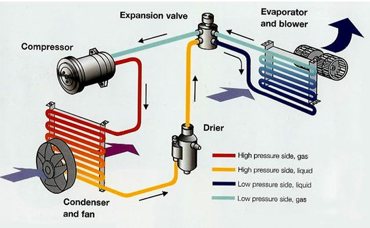 Ewing Automotive has all the knowledge and equipment to keep your cars air conditioning and heating system in great working order.
If your car’s air-conditioning system blows only warm air on hot days, it’s probably because it is low on refrigerant, and the most likely cause is a leak somewhere in the system.
Though many vehicle owners think they need to recharge or “top off” their air-conditioning system with refrigerant annually, that’s not the case. If the air conditioning stops working (but the fan continues to blow warm air), a leak in a hose, compressor or other component of the system is probably the culprit. During the winter, you may notice that the defroster isn’t clearing fogged up windows, and that also is a sign you have a leak. Most defrosters engage the air conditioning to dehumidify the air.
If there is a leak, the air-conditioning system on most modern vehicles is designed to shut down once the refrigerant level drops low enough in order to prevent damage to the air-conditioning compressor. The refrigerant in your cars air conditioner is what circulates the oil to lubricate the compressor.
The EPA provides helpful information for consumers about whether they should have their air conditioner topped off with refrigerant or evacuated and recharged. The EPA notes that a repair shop (or a do-it-yourselfer) can’t tell precisely how much refrigerant is in the system without the proper equipment. The use of a recover, recycle, recharge and evacuate unit is required to make sure the system is full but not over charged.
By performing a complete evacuation and recharge the repair shop will be able to test the complete system and recharge it with the precise amount of refrigerant recommended by the vehicle manufacturer.
When is it time to add or replace the refrigerant? You could be proactive and have it done before you experience problems, but you shouldn’t need that more often than every few years at the most. If your air conditioning is losing its potency, even after topping it off, then you probably have a leak. If you stay cool on the hottest days, you could just leave well enough alone.
If the heat in your car isn’t blowing hot like it should, the repair may be as simple as flushing the cooling system or replacing your thermostat.
Ewing Automotive has all the knowledge and equipment to keep your cars air conditioning and heating system in great working order.
If your car’s air-conditioning system blows only warm air on hot days, it’s probably because it is low on refrigerant, and the most likely cause is a leak somewhere in the system.
Though many vehicle owners think they need to recharge or “top off” their air-conditioning system with refrigerant annually, that’s not the case. If the air conditioning stops working (but the fan continues to blow warm air), a leak in a hose, compressor or other component of the system is probably the culprit. During the winter, you may notice that the defroster isn’t clearing fogged up windows, and that also is a sign you have a leak. Most defrosters engage the air conditioning to dehumidify the air.
If there is a leak, the air-conditioning system on most modern vehicles is designed to shut down once the refrigerant level drops low enough in order to prevent damage to the air-conditioning compressor. The refrigerant in your cars air conditioner is what circulates the oil to lubricate the compressor.
The EPA provides helpful information for consumers about whether they should have their air conditioner topped off with refrigerant or evacuated and recharged. The EPA notes that a repair shop (or a do-it-yourselfer) can’t tell precisely how much refrigerant is in the system without the proper equipment. The use of a recover, recycle, recharge and evacuate unit is required to make sure the system is full but not over charged.
By performing a complete evacuation and recharge the repair shop will be able to test the complete system and recharge it with the precise amount of refrigerant recommended by the vehicle manufacturer.
When is it time to add or replace the refrigerant? You could be proactive and have it done before you experience problems, but you shouldn’t need that more often than every few years at the most. If your air conditioning is losing its potency, even after topping it off, then you probably have a leak. If you stay cool on the hottest days, you could just leave well enough alone.
If the heat in your car isn’t blowing hot like it should, the repair may be as simple as flushing the cooling system or replacing your thermostat.  Ewing Automotive offers full brake services as well as all brands of tires. We also offer alignments at our Monroe location. Are your brakes starting to squeak? Don’t ignore the noise.
Brake noise is not normal and is a certain sign that something is wrong. The brakes are the most important part of your car and shouldn’t be ignored or neglected. Without them you cannot stop! Tires are also very important to your safety.
They are what connect your car to the road. Worn tires increase stopping distances and decrease your steering ability in wet weather. Your cars alignment may cause premature tire wear if it is not correct. It may also affect your vehicles handling.
Ewing Automotive offers full brake services as well as all brands of tires. We also offer alignments at our Monroe location. Are your brakes starting to squeak? Don’t ignore the noise.
Brake noise is not normal and is a certain sign that something is wrong. The brakes are the most important part of your car and shouldn’t be ignored or neglected. Without them you cannot stop! Tires are also very important to your safety.
They are what connect your car to the road. Worn tires increase stopping distances and decrease your steering ability in wet weather. Your cars alignment may cause premature tire wear if it is not correct. It may also affect your vehicles handling. 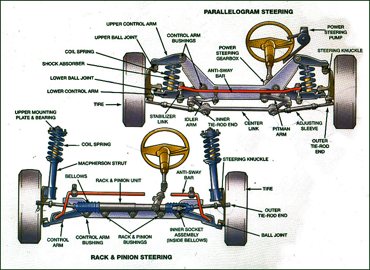 Ewing Automotives certified technicians have the knowledge and equipment to diagnose and repair your cars steering and suspension system.
Our vehicle’s suspension system (i.e., shocks or struts) is something we often take for granted. However, after supporting several tons of metal year after year, eventually the shocks will wear out and suspension repair will be necessary. Some people mistakenly believe the suspension is mainly about having a smooth ride, and therefore these repairs aren’t as important as other maintenance issues like oil changes or brakes. However, having a bad suspension can greatly affect your ability to control the vehicle, especially when stopping or turning, so it’s in your best interest not to ignore this part of auto maintenance.
How do you know when it’s time for suspension repair? Your vehicle will usually tell you. Here are six things to watch for. Most people can tell their shocks or struts are wearing out when they begin to feel every bump in the road, or when every bump causes the vehicle body to “bounce.” A rough ride is an obvious sign that your vehicle’s suspension needs work.
With a failing suspension system, you’ll often feel the vehicle “drift” or “pull” when you’re turning. This basically means the shocks are no longer keeping the vehicle body stable against the centrifugal force of a turn, increasing your risk of a rollover. If you feel this sensation while turning, it’s time to take the car to Ewing Automotive for servicing.
When the shocks are worn out, you’re likely to feel the vehicle body lurching forward and downward nose-first when you apply the brakes firmly. This can actually affect your ability to stop the car quickly (a bad suspension can increase stop time by up to 20 percent).
If you can look under the vehicle, take a look directly at the shocks or struts. If they look greasy or oily, there’s a good chance that they are leaking fluid and therefore aren’t working properly. It’s probably time to get those shocks replaced.
If you suspect your suspension is going bad (perhaps due to one or more of the symptoms we mentioned above), try this simple test. With the car in “park,” press down on the front of the vehicle with all your weight, “bounce” it a few times, then release. Do it again on the rear of the vehicle. If the car continues to rock or bounce more than 2-3 times after you release it, the suspension is wearing out.
Ewing Automotives certified technicians have the knowledge and equipment to diagnose and repair your cars steering and suspension system.
Our vehicle’s suspension system (i.e., shocks or struts) is something we often take for granted. However, after supporting several tons of metal year after year, eventually the shocks will wear out and suspension repair will be necessary. Some people mistakenly believe the suspension is mainly about having a smooth ride, and therefore these repairs aren’t as important as other maintenance issues like oil changes or brakes. However, having a bad suspension can greatly affect your ability to control the vehicle, especially when stopping or turning, so it’s in your best interest not to ignore this part of auto maintenance.
How do you know when it’s time for suspension repair? Your vehicle will usually tell you. Here are six things to watch for. Most people can tell their shocks or struts are wearing out when they begin to feel every bump in the road, or when every bump causes the vehicle body to “bounce.” A rough ride is an obvious sign that your vehicle’s suspension needs work.
With a failing suspension system, you’ll often feel the vehicle “drift” or “pull” when you’re turning. This basically means the shocks are no longer keeping the vehicle body stable against the centrifugal force of a turn, increasing your risk of a rollover. If you feel this sensation while turning, it’s time to take the car to Ewing Automotive for servicing.
When the shocks are worn out, you’re likely to feel the vehicle body lurching forward and downward nose-first when you apply the brakes firmly. This can actually affect your ability to stop the car quickly (a bad suspension can increase stop time by up to 20 percent).
If you can look under the vehicle, take a look directly at the shocks or struts. If they look greasy or oily, there’s a good chance that they are leaking fluid and therefore aren’t working properly. It’s probably time to get those shocks replaced.
If you suspect your suspension is going bad (perhaps due to one or more of the symptoms we mentioned above), try this simple test. With the car in “park,” press down on the front of the vehicle with all your weight, “bounce” it a few times, then release. Do it again on the rear of the vehicle. If the car continues to rock or bounce more than 2-3 times after you release it, the suspension is wearing out.  We’re often asked questions about the cooling system – the system that cools your engine and keeps it at the proper operating temperature. Let’s examine the topic in two areas: first the coolant itself and, second, the parts that make up the cooling system.
The coolant is the mix of water and antifreeze that circulates through the engine to draw off heat. First, you need to have the proper amount. If you don’t have enough coolant it can’t keep your engine cool.
You also need the right kind of coolant. Different makes of vehicles require different coolant formulation to protect against corrosion.
Finally, your coolant needs to be fresh. Over time and miles, the anti-corrosion additives in the coolant are depleted and the coolant can actually start to eat away at the cooling system parts. Your owner’s manual and your service adviser can help you with the recommended coolant replacement schedule and make sure you’re getting the right type of coolant.
Now let’s talk about the cooling system components. These will all eventually wear out and need to be replaced. Starting with the radiator, we see them coming into the shop with leaks or clogged with deposits. Depending on the damage, we will clean, repair or replace. We also see radiator pressure caps that can no longer hold the proper pressure. We recommend replacing pressure caps when you change your coolant to avoid this problem. We see leaky water pumps and hoses that need to be replaced. There’s also a part called the thermostat that opens and closes to regulate the flow of coolant. Sometimes they stick open or closed and the cooling system won’t work properly.
Engine damage from overheating can be very expensive to fix so it’s important to maintain your cooling system properly with scheduled coolant replacement and periodic inspections of the cooling system. Certainly come in if you suspect a leak and have us take a look.
We’re often asked questions about the cooling system – the system that cools your engine and keeps it at the proper operating temperature. Let’s examine the topic in two areas: first the coolant itself and, second, the parts that make up the cooling system.
The coolant is the mix of water and antifreeze that circulates through the engine to draw off heat. First, you need to have the proper amount. If you don’t have enough coolant it can’t keep your engine cool.
You also need the right kind of coolant. Different makes of vehicles require different coolant formulation to protect against corrosion.
Finally, your coolant needs to be fresh. Over time and miles, the anti-corrosion additives in the coolant are depleted and the coolant can actually start to eat away at the cooling system parts. Your owner’s manual and your service adviser can help you with the recommended coolant replacement schedule and make sure you’re getting the right type of coolant.
Now let’s talk about the cooling system components. These will all eventually wear out and need to be replaced. Starting with the radiator, we see them coming into the shop with leaks or clogged with deposits. Depending on the damage, we will clean, repair or replace. We also see radiator pressure caps that can no longer hold the proper pressure. We recommend replacing pressure caps when you change your coolant to avoid this problem. We see leaky water pumps and hoses that need to be replaced. There’s also a part called the thermostat that opens and closes to regulate the flow of coolant. Sometimes they stick open or closed and the cooling system won’t work properly.
Engine damage from overheating can be very expensive to fix so it’s important to maintain your cooling system properly with scheduled coolant replacement and periodic inspections of the cooling system. Certainly come in if you suspect a leak and have us take a look.  Preventative maintenance is the key to keeping your car or truck on the road for years to come. Neglecting the maintenance on your vehicle can lead to expensive repairs later on down the road. Ewing Automotive can help you maintain your vehicle by performing the routine maintenance your vehicle requires. Oil changes, fluid flushed using BG products, fuel induction services, filters and more. We also do complete tune ups to keep your car running great. Don’t forget about those belts & hoses. A serpentine belt should be replaced about every 60,000 miles. Glazing and cracking are indications that your belt needs to be replaced. When a serpentine belt breaks, your alternator, power steering and most importantly water pump can stop working and leave you stranded.
Coolant hoses should be replaced every 4 years or 60,000 miles. The rubber starts to deteriorate from the inside. When a coolant hose ruptures, the cars coolant will be lost and can cause your engine to overheat resulting in severe engine damage.
Having your belts and hoses replaced at the recommended intervals will help keep your car running properly and help you avoid a costly repair bill.
Preventative maintenance is the key to keeping your car or truck on the road for years to come. Neglecting the maintenance on your vehicle can lead to expensive repairs later on down the road. Ewing Automotive can help you maintain your vehicle by performing the routine maintenance your vehicle requires. Oil changes, fluid flushed using BG products, fuel induction services, filters and more. We also do complete tune ups to keep your car running great. Don’t forget about those belts & hoses. A serpentine belt should be replaced about every 60,000 miles. Glazing and cracking are indications that your belt needs to be replaced. When a serpentine belt breaks, your alternator, power steering and most importantly water pump can stop working and leave you stranded.
Coolant hoses should be replaced every 4 years or 60,000 miles. The rubber starts to deteriorate from the inside. When a coolant hose ruptures, the cars coolant will be lost and can cause your engine to overheat resulting in severe engine damage.
Having your belts and hoses replaced at the recommended intervals will help keep your car running properly and help you avoid a costly repair bill. 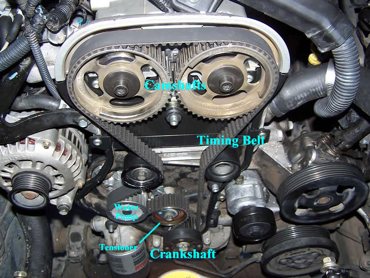 Ignoring Timing Belt Replacement Can Ruin Your Engine.
Your vehicle’s timing belt controls the timing of the engines valves. Not all vehicles have a timing belt. Some have chains. Others have gears. If your vehicle has a timing belt, it usually needs to be changed every 60,000 to 90,000 miles depending on the vehicle.
Ignoring your timing belt can ruin your engine. Disregarding a worn timing belt can cause engine valve issues, which are expensive to repair.
If your timing belt breaks, the engine will suddenly stop and may cause severe internal damage. That is why it is important to get your timing belt replaced every 60,000 to 75,000 miles.
When having your timing belt replaced, you should also replace your timing belt tensioner and idlers as well as the water pump, if the water pump is belt driven. The timing belt tensioner is the part of the engine that keeps the tension on the timing belt. Regularly changing your timing belt will ensure you get the maximum life out of your vehicle.
Be sure to write down the mileage of your vehicle when you get your timing belt replaced. That way, you will know when it’s time to replace it again. Remember, replacing your timing belt is just as important as changing your car’s oil. You need both to keep your car running.
Ignoring Timing Belt Replacement Can Ruin Your Engine.
Your vehicle’s timing belt controls the timing of the engines valves. Not all vehicles have a timing belt. Some have chains. Others have gears. If your vehicle has a timing belt, it usually needs to be changed every 60,000 to 90,000 miles depending on the vehicle.
Ignoring your timing belt can ruin your engine. Disregarding a worn timing belt can cause engine valve issues, which are expensive to repair.
If your timing belt breaks, the engine will suddenly stop and may cause severe internal damage. That is why it is important to get your timing belt replaced every 60,000 to 75,000 miles.
When having your timing belt replaced, you should also replace your timing belt tensioner and idlers as well as the water pump, if the water pump is belt driven. The timing belt tensioner is the part of the engine that keeps the tension on the timing belt. Regularly changing your timing belt will ensure you get the maximum life out of your vehicle.
Be sure to write down the mileage of your vehicle when you get your timing belt replaced. That way, you will know when it’s time to replace it again. Remember, replacing your timing belt is just as important as changing your car’s oil. You need both to keep your car running.  Ewing Automotive has the proper equipment and knowledge to check and repair your cars electrical system. We do starters, alternators and batteries as well as other automotive electrical repairs.
Why you shouldn’t disconnect your cars battery while it’s running:
The man from the road service thinks he’s being helpful. After he can’t jump start your car, he puts in his own known good battery and starts your car. So far so good — your battery was definitely either run down or bad, and he’s proven it.
Now he decides to “test” your alternator by disconnecting the battery. After all, the car’s ignition should be able to run on just the alternator’s power alone.
Wrong!
The moment he disconnects either lead from your battery, it’s entirely possible he caused thousands of dollars in damage. Here’s why…
Your battery does more than just provide electricity. It also shorts AC, spikes and transients to ground. Removing the battery from the circuit allows those spikes and transients to travel around, endangering every semiconductor circuit in your car. The ECU, the speed sensitive steering, the memory seat adjustments, the cruise control, and even the car’s stereo.
Even if your computers and stereo remain intact, in a great many cases removing the battery burns out the diodes in the alternator, necessitating a new alternator. If disconnecting the battery interferes with the voltage regulator’s control voltage input, it’s possible for the alternator voltage to go way over the top (I’ve heard some say hundreds of volts), frying everything.
Even the initial premise was wrong. If you disconnect the battery and the car conks out, you don’t know if it conked out due to insufficient alternator current, or whether the resulting transients caused your ECU (the car’s computer, which controls fuel mixture, timing, and much more) to spit out bad data, shutting down the car.
No one should EVER run your engine without a battery.
Ewing Automotive has the proper equipment and knowledge to check and repair your cars electrical system. We do starters, alternators and batteries as well as other automotive electrical repairs.
Why you shouldn’t disconnect your cars battery while it’s running:
The man from the road service thinks he’s being helpful. After he can’t jump start your car, he puts in his own known good battery and starts your car. So far so good — your battery was definitely either run down or bad, and he’s proven it.
Now he decides to “test” your alternator by disconnecting the battery. After all, the car’s ignition should be able to run on just the alternator’s power alone.
Wrong!
The moment he disconnects either lead from your battery, it’s entirely possible he caused thousands of dollars in damage. Here’s why…
Your battery does more than just provide electricity. It also shorts AC, spikes and transients to ground. Removing the battery from the circuit allows those spikes and transients to travel around, endangering every semiconductor circuit in your car. The ECU, the speed sensitive steering, the memory seat adjustments, the cruise control, and even the car’s stereo.
Even if your computers and stereo remain intact, in a great many cases removing the battery burns out the diodes in the alternator, necessitating a new alternator. If disconnecting the battery interferes with the voltage regulator’s control voltage input, it’s possible for the alternator voltage to go way over the top (I’ve heard some say hundreds of volts), frying everything.
Even the initial premise was wrong. If you disconnect the battery and the car conks out, you don’t know if it conked out due to insufficient alternator current, or whether the resulting transients caused your ECU (the car’s computer, which controls fuel mixture, timing, and much more) to spit out bad data, shutting down the car.
No one should EVER run your engine without a battery. 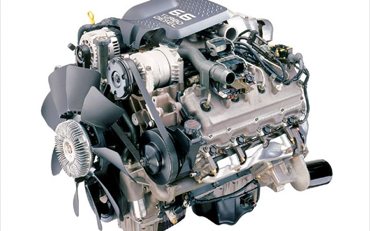 Ewing Automotive has the knowledge to service and repair your light and medium duty diesel. From maintenance to complete engines, we have you covered. We do injectors, high pressure oil pumps, injector pumps and more. We also do complete diagnostics on diesels.
We have the proper equipment to test and repair your diesel. We also have the ability to service and repair Allison Transmissions mechanically and electronically.
We proudly offer Jasper diesel engines as a replacement option if needed as well as OEM suppliers.
Ewing Automotive has the knowledge to service and repair your light and medium duty diesel. From maintenance to complete engines, we have you covered. We do injectors, high pressure oil pumps, injector pumps and more. We also do complete diagnostics on diesels.
We have the proper equipment to test and repair your diesel. We also have the ability to service and repair Allison Transmissions mechanically and electronically.
We proudly offer Jasper diesel engines as a replacement option if needed as well as OEM suppliers.  Ewing Automotive has been involved in professional drag racing for over 40 years. We know what it takes to build a high performance engine or transmission. From carburetors to complete engines we have you covered. Want a firmer shifting transmission?
We can install performance shift kits and convertors to give your car the punch you’re looking for. Want more horsepower? We can build a high performance engine, install a supercharger or turbo to give you the thrill you’re looking for.
Ewing Automotive has been involved in professional drag racing for over 40 years. We know what it takes to build a high performance engine or transmission. From carburetors to complete engines we have you covered. Want a firmer shifting transmission?
We can install performance shift kits and convertors to give your car the punch you’re looking for. Want more horsepower? We can build a high performance engine, install a supercharger or turbo to give you the thrill you’re looking for.